Family GaviidaeCoues, 1903 Higher classification Divers Rank Genus | Scientific name Gavia Phylum Chordata | |
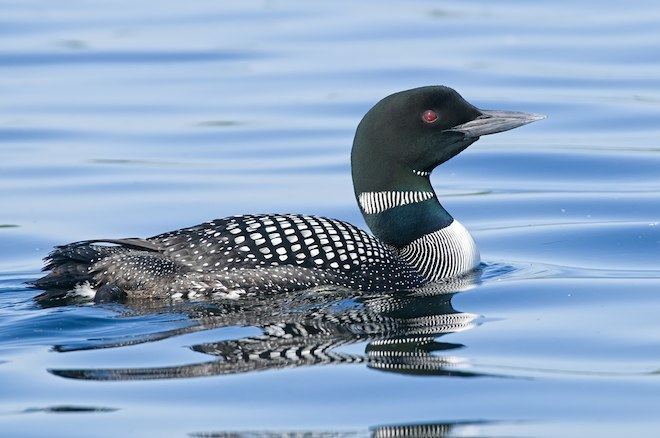 | ||
Lower classifications Common loon, Red‑throated loon, Black‑throated loon, Pacific loon, Yellow‑billed loon | ||
Voices common loon
The loons (North America) or divers (UK/Ireland) are a group of aquatic birds found in many parts of North America and northern Eurasia. All living species of loons are members of the genus Gavia, family Gaviidae and order Gaviiformes.
Contents
- Voices common loon
- Loons sounds of nature for relaxation
- Description
- Behaviour and ecology
- Diet and feeding
- Reproduction
- Etymology and taxonomy
- Systematics and evolution
- Relationships
- Fossil record
- In popular culture
- References
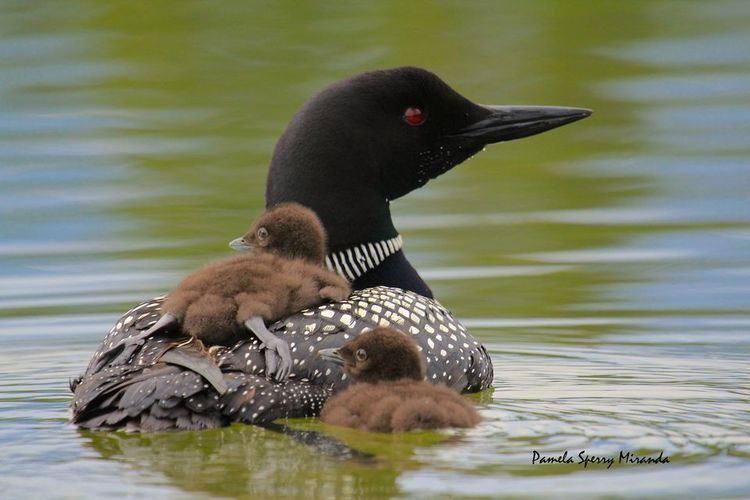
Loons sounds of nature for relaxation
Description
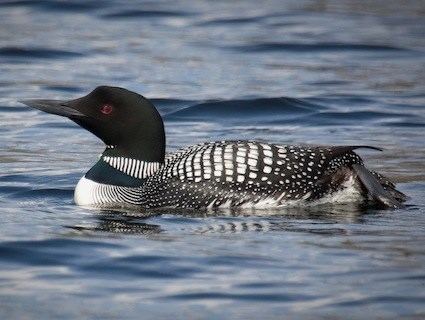
The loon, the size of a large duck or small goose, resembles these birds in shape when swimming. Like ducks and geese but unlike coots (which are Rallidae) and grebes (Podicipedidae), the loon's toes are connected by webbing. The bird may be confused with cormorants (Phalacrocoracidae), which are not too distant relatives of divers and like them are heavy set birds whose bellies – unlike those of ducks and geese – are submerged when swimming. Flying loons resemble plump geese with seagulls' wings that are relatively small in proportion to the bulky body. The bird points its head slightly upwards during swimming, but less so than cormorants. In flight the head droops more than in similar aquatic birds.
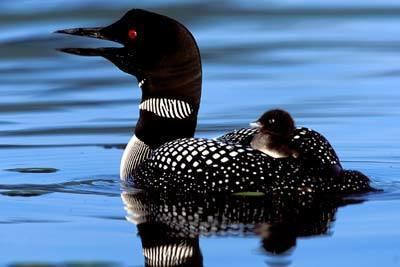
Male and female loons have identical plumage. Plumage is largely patterned black-and-white in summer, with grey on the head and neck in some species. All have a white belly. This resembles many sea-ducks (Merginae) – notably the smaller goldeneyes (Bucephala) – but is distinct from most cormorants which rarely have white feathers, and if so usually as large rounded patches rather than delicate patterns. All species of divers have a spear-shaped bill.
Males are larger on average, but relative size is only apparent when the male and female are together.
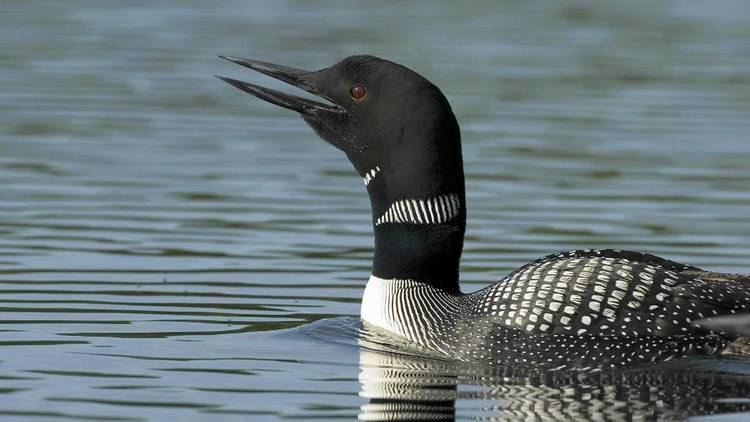
In winter plumage is dark grey above, with some indistinct lighter mottling on the wings, and a white chin, throat and underside. The species can then be distinguished by certain features, such as size and colour of head, neck, back and bill, but often reliable identification of wintering divers is difficult even for experts – particularly as the smaller immature birds look similar to winter-plumage adults, making size an unreliable means of identification.
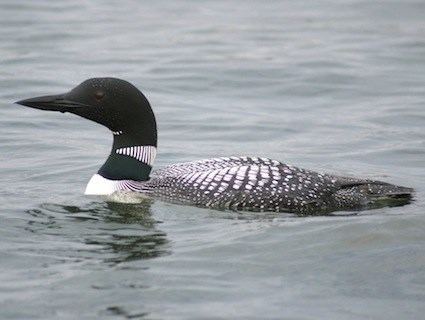
Gaviiformes are among the few groups of birds in which the young moult into a second coat of down feathers after shedding the first one, rather than growing juvenile feathers with downy tips that wear off as is typical in many birds. This trait is also found in tubenoses (Procellariiformes) and penguins (Sphenisciformes), both relatives of the loons.
Behaviour and ecology

Loons are excellent swimmers, using their feet to propel themselves above and under water. However, since their feet are located posteriorly on the body, loons cannot walk. Thus, loons avoid coming to land, except when nesting or severely injured.
Loons fly strongly, though they have high wing-loading (mass to wing area ratio), which complicates takeoff. Indeed, most species must run upwind across the water's surface with wings flapping to generate sufficient lift to take flight. Only the red-throated loon (G. stellata) can take off from land. Once airborne, loons are capable of long flights during migration. Scientists from the U.S. Geological Survey, who have implanted satellite transmitters in some individuals, have recorded daily flights of up to 1078 km in a 24-hour period, which probably resulted from single movements. North European loons migrate primarily via the South Baltic and directly over land to the Black Sea or Mediterranean. Loons can live as long as 30 years and can hold their breath for as long as 90 seconds while underwater.
Diet and feeding
Loons find their prey by sight. They eat mainly fish, supplemented with amphibians, crustaceans and similar mid-sized aquatic fauna. Specifically, they have been noted to feed on crayfish, frogs, snails, salamanders and leeches. They prefer clear lakes because they can more easily see their prey through the water. The loon uses its pointy bill to stab or grasp prey. They eat vertebrate prey headfirst to facilitate swallowing, and swallow all their prey whole.
To help digestion, loons swallow small pebbles from the bottoms of lakes. Similar to grit eaten by chickens, these gastroliths may assist the loon's gizzard in crushing the hard parts of the loon's food such as the exoskeletons of crustaceans and the bones of frogs and salamanders. The gastroliths may also be involved in stomach cleaning as an aid to regurgitation of indigestible food parts.
Loons may inadvertently ingest small lead pellets, released by anglers and hunters, that will contribute to lead poisoning and the loon's eventual death. Jurisdictions that have banned the use of lead shot and sinkers include but are not limited to Maine, New Hampshire, Vermont, some areas of Massachusetts, Yellowstone National Park, Great Britain, Canada, Michigan, and Denmark.
Reproduction
Loons nest during the summer on freshwater lakes and/or large ponds. Smaller bodies of water (up to 0.5 km2) will usually only have one pair. Larger lakes may have more than one pair, with each pair occupying a bay or section of the lake. The red-throated loon, however, may nest colonially, several pairs close together, in small Arctic tarns and feed at sea or in larger lakes, ferrying the food in for the young.
Loons mate on land, often on the future nest site, and build their nests close to the water, preferring sites that are completely surrounded by water such as islands or emergent vegetation. Loons use a variety of materials to build their nests including aquatic vegetation, pine needles, leaves, grass, moss and mud. Sometimes, nest material is almost lacking. Both male and female build the nest and incubate jointly for 28 days. If the eggs are lost, the pair may re-nest, usually in a different location. Since the nest is very close to the water, rising water may induce the birds to slowly move the nest upwards, over a meter.
Despite the roughly equal participation of the sexes in nest building and incubation, analysis has shown clearly that males alone select the location of the nest. This pattern has the important consequence that male loons, but not females, establish significant site-familiarity with their territories that allows them to produce more chicks there over time. Sex-biased site-familiarity might explain, in part, why resident males fight so hard to defend their territories.
Most clutches consist of two eggs, which are laid in May or June, depending upon latitude. Loon chicks are precocial, able to swim and dive right away, but will often ride on their parents' back during their first two weeks to rest, conserve heat, and avoid predators.
Chicks are fed mainly by their parents for about six weeks but gradually begin to feed themselves over time. By 11 or 12 weeks, chicks gather almost all of their own food and have begun to fly.
Biologists, especially from Chapman University, have extensively studied the mating behaviour of the common loon (G. immer). Contrary to popular belief, pairs seldom mate for life. Indeed, a typical adult loon is likely to have several mates during its lifetime because of territorial takeover. Each breeding pair must frequently defend its territory against "floaters" (territory-less adults) trying to evict at least one owner and seize the breeding site. Territories that have produced chicks in the past year are especially prone to takeovers, because nonbreeding loons use chicks as cues to indicate high-quality territories. One-third of all territorial evictions among males result in the death of the owner; in contrast, female loons usually survive. Birds that are displaced from a territory but survive usually try to remate and (re)claim a breeding territory later in life.
Etymology and taxonomy
The European Anglophone name "diver" comes from the bird's habit of catching fish by swimming calmly along the surface and then abruptly plunging into the water. The North American name "loon" likely comes from either the Old English word lumme, meaning lummox or awkward person, or the Scandinavian word lum meaning lame or clumsy. Either way, the name refers to the loon’s poor ability to walk on land. Another possible derivation is from the Norwegian word lom for these birds, which comes from Old Norse lómr, possibly cognate with English "lament", referring to the characteristic plaintive sound of the loon. The scientific name Gavia refers to seabirds in general.
The scientific name Gavia was the Latin term for the smew (Mergellus albellus). This small sea-duck is quite unrelated to loons and just happens to be another black-and-white seabird which swims and dives for fish. It is not likely that the ancient Romans had much knowledge of loons, as these are limited to more northern latitudes and since the end of the last glacial period seem to have occurred only as rare winter migrants in the Mediterranean region.
The term gavia was transferred from the ducks to the loons only in the 18th century. Earlier naturalists referred to the loons as mergus (the Latin term for diving seabirds of all sorts) or colymbus, which became the genus name used in the first modern scientific description of a Gavia species (by Carl Linnaeus) in 1758. Unfortunately, confusion about whether Linnaeus' "wastebin genus" Colymbus referred to loons or grebes abounded, with North American ornithologists using the genus name for grebes and European ones, following Nicholas Aylward Vigors and Richard Bowdler Sharpe, for divers. The International Commission on Zoological Nomenclature tried to settle this issue in 1956 by declaring Colymbus a suppressed name unfit for further use and establishing Gavia, created by Johann Reinhold Forster in 1788, as the valid genus name for the loons. However, the situation was not completely resolved even then, and the following year the ICZN had to act again to prevent Louis Jean Pierre Vieillot's 1818 almost-forgotten family name Urinatoridae from overruling the much younger Gaviidae. Some eminent ornithologists such as Pierce Brodkorb tried to keep the debate alive but the ICZN's solution has been satisfactory.
Systematics and evolution
All living species are placed in the genus Gavia. Phylogenetically, the five living species can be arranged as follows:
Basal lineage
Black-throated lineage
Black-headed lineage
Relationships
The loons were formerly often considered to be the most ancient of the northern hemisphere bird families; this idea grew basically out of the perceived similarity of shape and (probably) habits between loons and the entirely unrelated extinct Cretaceous order Hesperornithiformes. In particular Enaliornis, which was apparently an ancestral and plesiomorphic member of that order, was sometimes used to support claims of Albian (Early Cretaceous) Gaviiformes.
More recently, it has become clear that the Anseriformes (waterfowl) and the Galliformes are the most ancient groups of modern birds. It is possible, though not at all well-supported, that these were distinct by the end of the Albian 100 million years ago (Ma). Loons belong to a more modern radiation. They were once believed to be related to grebes, which are also foot-propelled diving birds, and both species were once classified together under the order Colymbiformes. However, as recently as the 1930s, it was determined that the two groups are not that closely related at all and are merely the product of convergent evolution and adapted in a similar way to a similar ecological niche. The similarity is so strong that even the most modern cladistic analyses of general anatomical features are easily misled into grouping loons and grebes.
The Sibley-Ahlquist taxonomy still allied the loons with the grebes in its massively paraphyletic "Ciconiiformes", and it is almost certain that the relationships of loons lie with some of the orders placed therein. Namely, other recent authors have considered loons to share a rather close relationship with seabirds such as penguins (Sphenisciformes), tubenoses (Procellariiformes), waders (Charadriiformes) – and perhaps the newly discovered clade Mirandornithes which unites grebes (Podicipediformes) and their closest living relatives, the flamingos (Phoenicopteriformes). It is perhaps notable that some early penguins had skulls and beaks that were in many aspects similar to those of the living and fossil Gaviiformes.
Fossil record
In prehistoric times, the loons had a more southerly distribution than today, and their fossils have been found in places such as California, Florida and Italy. The conflicting molecular data regarding their relationships is not much resolved by the fossil record; though they seem to have originated at the end of the Late Cretaceous like their presumed relatives, modern loons are only known with certainty since the Eocene. By that time almost all modern bird orders are at least strongly suspected to have existed – if not known from unequivocally identified specimens – anyway.
Colymboides, the oldest unequivocal gaviiform genus known as of 2009, is widely known from early Priabonian – about 37 million years ago (Ma) in the Late Eocene – to Early Miocene (late Burdigalian, less than 20 Ma) limnic and marine rocks of western Eurasia north of the Alpide belt, between the Atlantic and the former Turgai Sea. It is usually placed in the Gaviidae already, but usually in a subfamily Colymboidinae, with the modern-type loons making up the Gaviinae. But the Colymboides material is generally quite distinct from modern loons, and may actually belong in a now-extinct family of primitive gaviiforms. Furthermore, the supposed genus could well be paraphyletic, so that for example Dyspetornis – which is now contained therein – might have to be separated again. A leg of an undescribed small diver was found in the Late Oligocene deposits at Enspel (Germany); it too may or may not belong to Colymboides. Of the crown genus Gavia, nearly ten prehistoric species have been named to date, and about as many undescribed ones await further study. The genus is known from the Early Miocene onwards, and the oldest members them are rather small (some are smaller than the red-throated diver). Throughout the late Neogene, the genus by and large follows Cope's Rule.
List of fossil Gavia
"Gavia" portisi from the Late Pliocene of Orciano Pisano, Italy, is known from a cervical vertebra that may or may not have been from a loon. If so, it was from a bird slightly smaller than the common loon. Older authors were quite sure the bone was indeed from a Gavia and even considered G. concinna a possibly junior synonym of it. This is now regarded as rather unlikely due to the quite distinct range and age. Interestingly, the Early Pliocene Gavia skull from Empoli (Italy) was referred to G. concinna, and thus could conceivably have been of "G." portisi if that was indeed a diver. The holotype vertebra may now be lost, which would make "G." portisi a nomen dubium.
In addition, there are some older fossils that are sometimes assigned to the Gaviiformes. From the Late Cretaceous, the genera Lonchodytes (Lance Formation, Wyoming, United States) and Neogaeornis (Quinriquina Formation, Chile) have been described; both are usually allied with orders which are considered related to loons. In particular the latter is still sometimes explicitly proposed as a primitive loon as they both were initially, but other authors consider Neogaeornis a hesperornithiform; note however that neither Gaviiformes nor Hesperornithiformes are known from the Southern Hemisphere or anywhere near it. Lonchodytes was more certainly quite close to loons, but probably closer still to some of the loons' relatives. Of similarly doubtful validity and surrounded by considerable dispute is the supposed Late Cretaceous loon Polarornis (Seymour Island, Antarctica). Eupterornis from the Paleocene of Châlons-sur-Vesle (France) has some features reminiscent of loons, but others seem more similar to Charadriiformes such as gulls (Laridae). A piece of a carpometacarpus supposedly from Oligocene rocks near Lusk, Wyoming, was described as Gaviella pusilla, but this handbone also shows some similarities to the plotopterids which were flightless wing-propelled divers and if these are apomorphic would make an unconvincing member of the Gaviidae (though it still could be a small-winged gaviiform in a yet-undescribed family "Gaviellidae"): while the carpometacarpus in Gavia is somewhat convergent to that of wing-propelled divers, enabling the wings to be used as rudders for quick underwater turns, Colymboides still had an unspecialized plesiomorphic hand. Parascaniornis, sometimes allied to the loons by early authors, was eventually determined to be a junior synonym of the hesperornithiform Baptornis. A supposed mid-Eocene diver fossil form Geiseltal (Germany) was erroneously assigned to Gavia.
